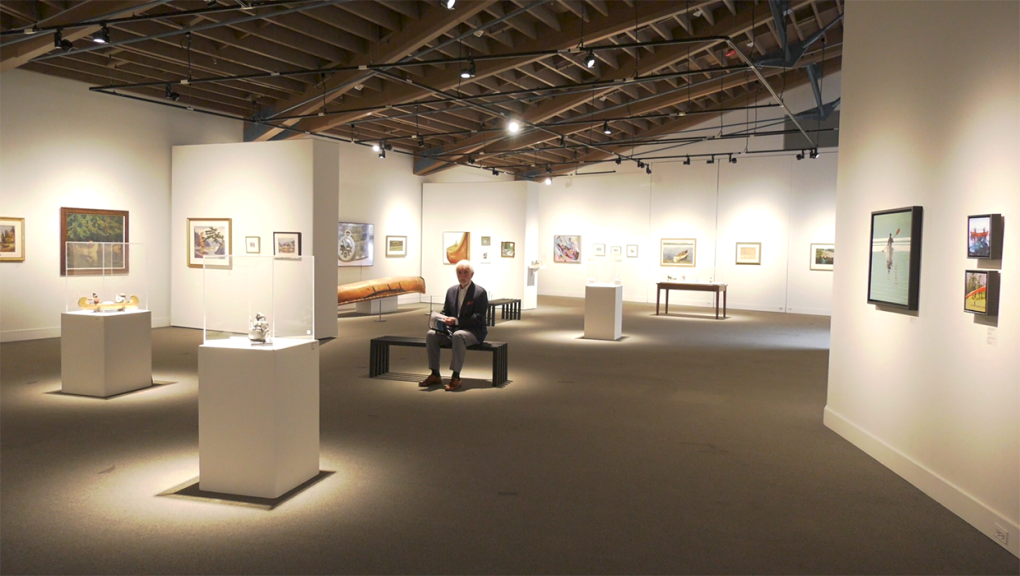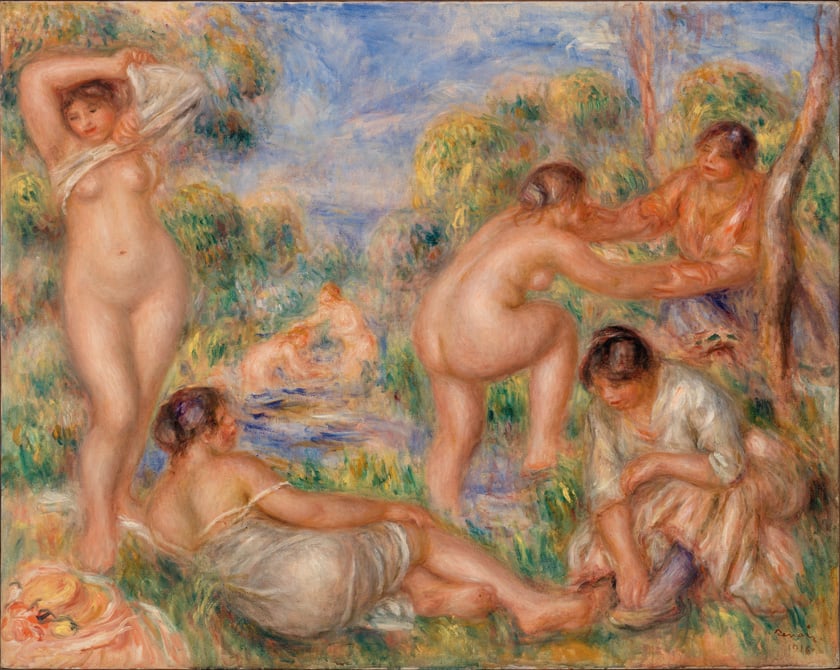Art
Canoes in art on display at Whyte Museum | CTV News – CTV News Calgary


It’s taken 20 years to amass the rare collection of roughly 90 works of canoes in art from 48 artists that are owned by Grit and Scott McCreath. This is the first time the collection has been displayed in its entirety.
Rod Green is a friend of the McCreath family and a retired art dealer who ran Masters Gallery in Calgary. He helped them acquire all the canoe art. Green says it all started with one painting when Grit was looking for a birthday present for her husband Scott who had fond memories of canoeing with his father in Saskatchewan.
“I showed (Grit a painting by) Lucius O’Brien which is called Denizens of Ottawa from 1875,” he said. “It’s a small picture, it’s like six by eight (inches) and she thought that would be perfect.”
Over two decades Green would find art featuring canoes and show them to the McCreaths who snapped them up. And the collection is vast.
“It’s watercolors, oils and sculptures, it’s three dimensional works,” said Green. “There (are) prints, folk art, video and a couple of real canoes, they’ve never had it all together in one place.”
The works span a 200 year time frame and are presented in chronological order in a gallery at the Whyte Museum of the Canadian Rockies. Anne Ewen is the chief curator at the museum and knows the family. On a visit to the McCreath home she was admiring all the canoes in art.
“At one point I was commenting, you know (saying) wow, I really liked this painting and I really liked that one,” said Ewen. “They said, well would you like to borrow them and I said, well I’d like to borrow all of them and they very generously said okay.”
CANOES PLAYED IMPORTANT ROLE
Ewen is honoured to be chosen to host the exhibit and says canoes had an important role in the development of Canada.
“The canoe was absolutely important to the discovery of western Canada, in fact it was important to Canada as a whole,” she said. “We wouldn’t have come this far (west) without the Indigenous population helping us to get here via canoe, when you think about all the settlers that came through by canoe and the trading that went on by canoe, it’s really spectacular.”
The newest piece to the collection is by artist John Fraser who was a contract artist for the Canadian Pacific Railway.
“It’s one of the finest monumental canvases of the 1880s,” said Green. “But those paintings over the last 140 years have just disappeared, there were maybe a dozen artists who were contract artists, some of them are on the walls around us right here in the 19th century selection but you can’t find them anymore.”
Green says the Fraser piece is in excellent condition and is of a camp at the top of Rogers Pass.
“The mountain is now (called) Mount Sir Donald but it was Mount Carroll and so it’s called the fishing camp,” he said “It’s really a beautiful picture, the frame’s original and it’s a real cornerstone of the collection.”
All the art can be viewed at the museum in Banff until October 2022.
“After the show closes here all the work will go back into a private collection and never, I think, to be seen again in its entirety,” said Ewen. “So I really mean it when I say it’s just such a privilege to have it.”
Learn more about the exhibit here: www.whyte.org
Art
Norman Lear's Art Goes to Auction – The New York Times


Norman Lear was best known for what he created on television, but he also appreciated the kind of art you can hang on the wall and collected his fair share over the years.
Lear died in December at 101. On May 16, his wife, Lyn, is selling seven of the producer’s prime pieces of artwork at Christie’s with a total estimate of more than $50 million.
The artworks will be featured in the auction house’s evening sale of 20th-century art, with additional works offered in the postwar and contemporary art day sales and subsequent auctions.
“It will be like letting go of old friends and moving on to make new friends,” Lyn Davis Lear said in a telephone interview, adding, “Norman’s philosophy was buy what you love, don’t buy anything thinking you’re going to make a lot of money.”
Norman Lear — whose string of hits included “All in the Family,” “The Jeffersons,” “Good Times” and “Maude” — mostly collected works from the 1950s through the 1980s and was particularly drawn to artists who blossomed in California, as he did.
“This is where he really flowered and was able to express himself,” Davis Lear said. “There was freedom about being in L.A.”
The Lears built a whole wall in their former Brentwood home to accommodate their Rauschenberg spread painting, Davis Lear said. And Norman gave her a painting by Mark Rothko for her birthday 20 years ago.
As for her late husband’s memorabilia, Davis Lear said she plans to sell that in future auctions.
The Christie’s sale includes David Hockney’s “A Lawn Being Sprinkled,” estimated at $25 million to $35 million, and Ed Ruscha’s “Truth” (estimated at $7 million to $10 million) as well as works by Ellsworth Kelly and Joseph Cornell.
“There is a pretty tight, fascinating link between the pictures and artists that Norman and Lyn gravitated toward and the shows he created,” Max Carter, Christie’s vice chairman of 20th and 21st-century art, Americas, said in an interview. “They’re about big ideas like truth and memory and time.”
Davis Lear said Norman particularly loved Ruscha’s “Truth,” since that was such an important theme for him. “Everything he did in television and in politics was all about finding meaning,” she said, “what was true and what wasn’t.”
Norman Lear’s early purchases were guided in large part by the producer and collector Richard Dorso, whom Davis Lear described as an “art mentor.”
“They would go around to the galleries,” she said, adding that her husband “just chose pieces that he loved.”
Also for sale is Roy Lichtenstein’s collage “I Love Liberty,” which the artist made to help support People for the American Way, Norman Lear’s liberal advocacy organization.
Davis Lear said that she looks forward to having their artwork enjoyed by others, particularly the pieces they didn’t have space to display. “I can’t bear for art to be in storage,” she said. “I just think it should be out there and be seen.”
Proceeds from the sale will go to the Lear Trust estate, Davis Lear said, as well as to his children and the funding of future art purchases. “I want to buy new artists that we can fill the walls with,” she said, “because I think there is such joy in that.”
Art
Art Bites: The Movement to Remove Renoir From Museums – artnet News
What’s the deal with Leonardo’s harpsichord-viola? Why were Impressionists obsessed with the color purple? Art Bitesbrings you a surprising fact, lesser-known anecdote, or curious event from art history. These delightful nuggets shed light on the lives of famed artists and decode their practices, while adding new layers of intrigue to celebrated masterpieces.
From Just Stop Oil to Free Palestine to P.A.I.N., recent times have seen art museums coopted as staging grounds for high-minded protest.
In 2015, however, the group of protesters that picketed outside Museum of Fine Arts in Boston had a simpler, less lofty target: Pierre-Auguste Renoir. Their demand? That museums remove his paintings from their walls. Their reasoning was rather straightforward: they argued Renoir was bad at art. (A protest at New York’s Metropolitan Museum of Art was soon to follow.)
The Renoir Sucks at Painting movement (if one can call it that) was the brainchild of Max Geller, and came to life after he encountered the sizable collection of Renoir paintings at Philadelphia’s Barnes Foundation. Its central outlet is an Instagram account that features close-ups of Renoir paintings accompanied by satirical, often long-winded critiques.
Armed with snobbish hipster fury and signage that read “God Hates Renoir,” “ReNOir,” and “We’re Not Iconoclasts, Renoir Just Sucks At Painting,” the group briefly received considerable media attention—though none from the institutions it was heckling. Fellow Renoir haters expressed their aesthetic sympathy online by posting photographs of themselves giving the middle finger to Renoir paintings, often accompanied with the hashtag #renoirsucksatpainting.


Renoir haters outside Boston’s Museum of Fine Arts. Photo: Lane Turner via Boston Globe
The furor prompted Renoir’s great-great-granddaughter Genevieve Renoir to chime in. She argued the free market had spoken clearly in favor of her ancestor’s talent. The market said something that sounded like, “$78 million at Sotheby’s for Bal du moulin de la Galette na na na-na na.” Geller responded by saying the free market lacked judgement and taste, citing TV commercials, climate change, and the destruction of sea otter habitats as evidence. Fair enough.
This points to the deeper purpose of Renoir Sucks at Painting, one that was generally lost beneath the media noise and pithy takedowns. Geller wasn’t trying to censor Renoir through ridicule. He was hoping to force museums into reconsidering the artistic merits of the paintings on their walls and make change, ideally in favor of non-white male painters. He called it “cultural justice.”


Pierre-Auguste Renoir, Bathing Group (1916). Courtesy of the Barnes Collection.
Though Geller’s approach was decidedly contemporary, his root sentiment wasn’t. People have long hated Renoir. The loathing has both moral and aesthetic substance. On moral grounds, Renoir’s innumerable dumb-faced, unflattering female nudes have seen him posthumously charged with sexism. Adding to the ignominy was his anti-Semitism, as shown by his stance in the Dreyfus affair.
And yet even the aesthetic charges are somewhat personal. Renoir, a ceramicist by training, fell in with a Parisian clique that included Alfred Sisley and Claude Monet, anti-academic artists who would become part of the Impressionist movement. Bold color and depictions of modern life were in. Formalism, florid rococo details, and grand mythological scenes were out.
The problem was, Renoir quite liked these old things—“I am of the 18th century,” he once said—and when times got financially tough, he backtracked and began painting saccharine, bourgeois portraits. It made him rich, an international star even. In short, he’s seen as a sellout.
Critics argue Renoir paid no attention to line or composition (he painted as though on a pot, the charge runs) and ignored the contemporary concerns of his day. Most damning, seemingly, is the accusation that Renoir’s paintings are pretty. Good art, of course, cannot simply be pretty.
One fan of Renoir’s pretty little paintings? Donald Trump. He claims to own Two Sisters (On the Terrace). It’s a fake, mind you.
Follow Artnet News on Facebook:
Want to stay ahead of the art world? Subscribe to our newsletter to get the breaking news, eye-opening interviews, and incisive critical takes that drive the conversation forward.
Art
New Art of Punjabi Exhibit – CTV News Barrie
-
Media20 hours ago
DJT Stock Plunges After Trump Media Files to Issue Shares
-
Business19 hours ago
FFAW, ASP Pleased With Resumption of Crab Fishery – VOCM
-
Media19 hours ago
Marjorie Taylor Greene won’t say what happened to her Trump Media stock
-
Business20 hours ago
Javier Blas 10 Things Oil Traders Need to Know About Iran's Attack on Israel – OilPrice.com
-



 Politics20 hours ago
Politics20 hours agoIn cutting out politics, A24 movie 'Civil War' fails viewers – Los Angeles Times
-
Media18 hours ago
Trump Media stock slides again to bring it nearly 60% below its peak as euphoria fades – National Post
-
Investment21 hours ago
A Once-in-a-Generation Investment Opportunity: 1 Top Artificial Intelligence (AI) Stock to Buy Hand Over Fist in April … – Yahoo Finance
-
Art21 hours ago
It’s Time to Remove Father Rupnik’s Art – National Catholic Register




